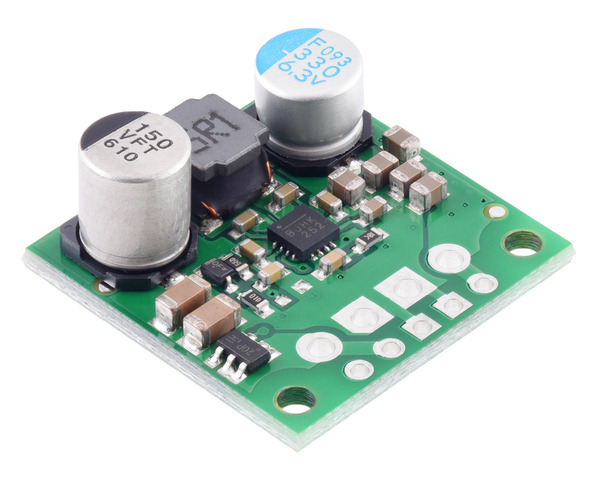Voltage Regulators and Power Supplies » Step-Up/Step-Down Voltage Regulators » S13VxFx Step-Up/Step-Down Voltage Regulators »
5V, 3A Step-Up/Step-Down Voltage Regulator S13V30F5
| Output voltage | Typical max output current* |
Input voltage range | Size | Optional enable input |
Reverse voltage protection |
|---|---|---|---|---|---|
| 5 V | 3 A | 2.8 V – 22 V | 0.9″ × 0.9″ | Up to 20 V |
*For input voltages close to the output. Actual achievable maximum continuous current is a function of input voltage and is limited by thermal dissipation. See the output current graphs on the product page for more information.
Alternatives available with variations in these parameter(s): output voltage Select variant…
Alternatives available with variations in these parameter(s): continuous output current Select variant…
 Compare all products in S13VxFx Step-Up/Step-Down Voltage Regulators.
Compare all products in S13VxFx Step-Up/Step-Down Voltage Regulators.
| Description | Specs (11) | Pictures (15) | Resources (3) | FAQs (0) | On the blog (3) | Distributors (49) |
|---|
Dimensions
| Size: | 0.9″ × 0.9″ × 0.38″1 |
|---|---|
| Weight: | 3.5 g2 |
General specifications
| Minimum operating voltage: | 2.8 V |
|---|---|
| Maximum operating voltage: | 22 V |
| Continuous output current: | 3 A3 |
| Output voltage: | 5 V |
| Reverse voltage protection?: | Y4 |
| Maximum quiescent current: | 100 mA5 |
| Output type: | fixed 5V |
Identifying markings
| PCB dev codes: | reg26a |
|---|---|
| Other PCB markings: | 0J12777 |
Notes:
- 1
- Without included optional headers or terminal blocks. Height with terminal blocks installed is approximately 0.5″.
- 2
- Without included optional headers or terminal blocks.
- 3
- Under typical conditions, where the input voltage is close to the output voltage. Actual achievable continuous output current is a function of input voltage and is limited by thermal dissipation. See the output current graph under the description tab for more information.
- 4
- To -20 V. Connecting supplies over 20 V in reverse can damage the device.
- 5
- While enabled with no load. Typically the quiescent current is much lower (under 20 mA). See the quiescent current graph under the description tab for more information. Can be reduced to under 1 mA using the enable pin.




























